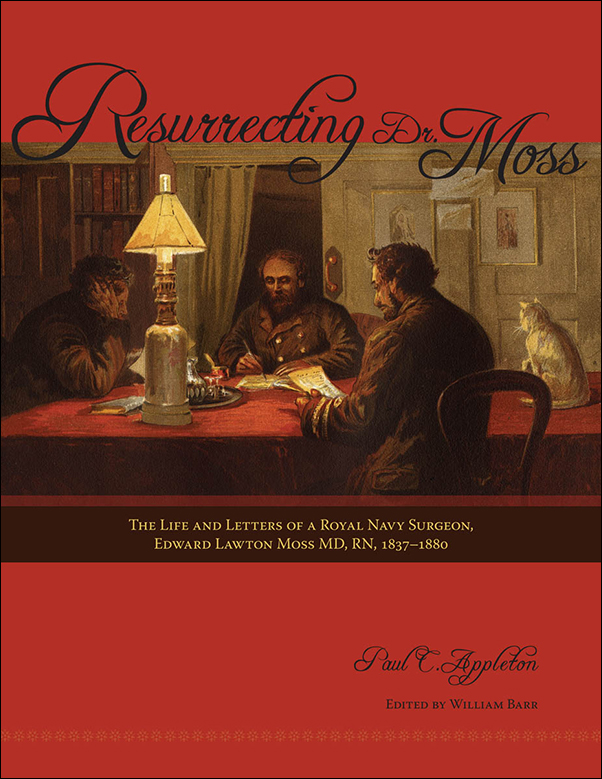
Resurrecting Dr. Moss: The Life and Letters of a Royal Navy Surgeon, Edward Lawton Moss MD, RN, 1843-1880
Paul C. Appleton, Edited by William Barr
268 pages, 30 illustrations
OUT OF PRINT
Resurrecting Dr. Moss chronicles the life and death of Edward Lawton Moss, a Royal Navy surgeon on the last great British north polar expedition of the nineteenth century.
Arctic historians and bibliophiles are familiar with Moss’s account of the 1875-76 British Arctic Expedition, published under the title Shores of the Polar Sea, but little has been known about Moss himself. Now, thanks to Paul Appleton’s painstaking research, his life has taken shape in this well-crafted biography.
Relying heavily on Moss’s own letters, Appleton recounts his travels in the Caribbean, the Arctic, and on Canada’s Pacific coast, creating a vivid portrait of a man he calls “an example of the best traditions of British naval medicine during the Victorian era.”
Artist, author, explorer, and scientist, Dr. Moss was also a pioneering medical officer. During his posting in British Columbia, he played a pivotal role in founding one of the earliest medical institutions on Canada’s west coast, the hospital at the Esquimalt Naval Base. Moss’s life was cut short at the age of thirty-seven when the HMS Atalanta disappeared en route from Bermuda in 1880.
Paul Appleton, a history teacher, earned his undergraduate and graduate degrees at the University of Calgary and pursued doctoral studies at Queen’s University. He published articles about Dr. Moss in BC Historical News, The Westcoaster, and Archaeology magazine. Paul Appleton died in March 2006.
William Barr is a research fellow at the Arctic Institute of North America. A glacial geomorphologist by training, his major research focus is the history of exploration in the Arctic, a subject on which he has published extensively. In May 2006, he received a lifetime achievement award from the Canadian Historical Association for his contributions to the historiography of the Canadian North.
List of Illustrations
List of Colour Plates
Acknowledgements
Editor’s Preface
Chapter 1: Guildford, Surrey—"The Letter"
Chapter 2: Dublin, Ireland—"Edward"
Chapter 3: Portsmouth—"The Royal Navy"
Chapter 4: Haiti—"For the Honour of the Flag"
Chapter 5: HMS Simoom—"Service Afloat"
Chapter 6: Portland, Dorset—"Service Ashore"
Chapter 7: British Columbia—"A Change of Course"
Chapter 8: Esquimalt—"His Own Master . . ."
Chapter 9: Esquimalt Hospital—"Do No Harm"
Chapter 10: Vancouver Island—"The Best of Times"
Chapter 11: England—"The Arctic Expedition"
Chapter 12: Greeland—"To the Shores of the Polar Sea"
Chapter 13: Floeberg Harbour—"Polar Winter"
Chapter 14: Markham and Parr—"Daring to Do All . . ."
Chapter 15: Aldrich and Beaumont—"Hearts of Oak"
Chapter 16: London—"Feet of Clay?"
Chapter 17: Kingston, Ireland—"Brief Interlude"
Chapter 18: Beshika Bay, Turkey—"Letters from Troy"
Chapter 19: HMS Atlanta—"The Perils of the Sea"
Chapter 20: London, April to June 1880—"Atlanta Feared Lost"
Chapter 21: Whitehall, London—"The Last Inquiry"
Epilogue
Colour Plates
Notes
Bibliography
Index
An admirably produced book.
—Trevor Levere, Scientia Canadensis
Highly engaging and informative.
—Cary Collins, BC Studies
Attractively produced . . . This book can be recommended, not just for describing the Nares Expedition and the life of Dr Moss. While every naval surgeon’s career was unique, the context in which their careers developed was the same. The Royal Navy was a major force in polar exploration, both north and south, and many of the medical officers who served on these expeditions have also been highly talented and this book will help to describe the context of their careers as well.
—Henry Guly, Polar Record